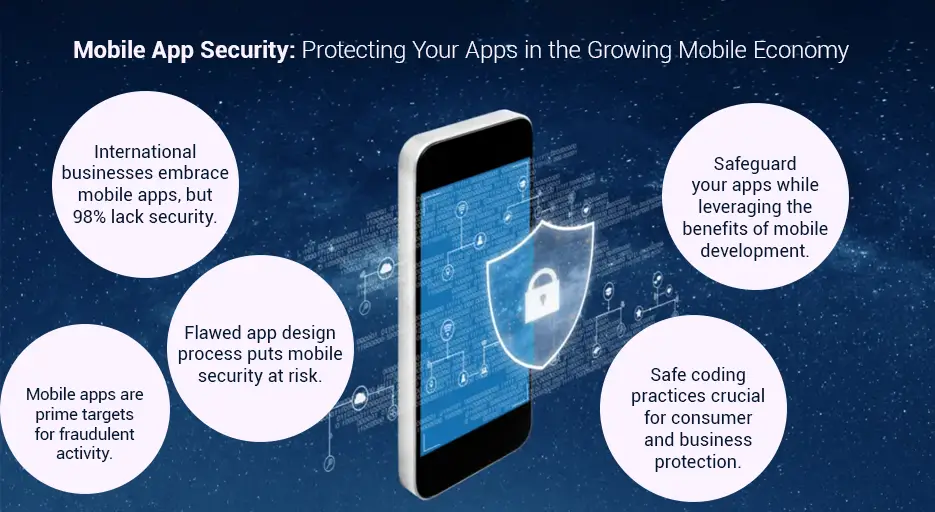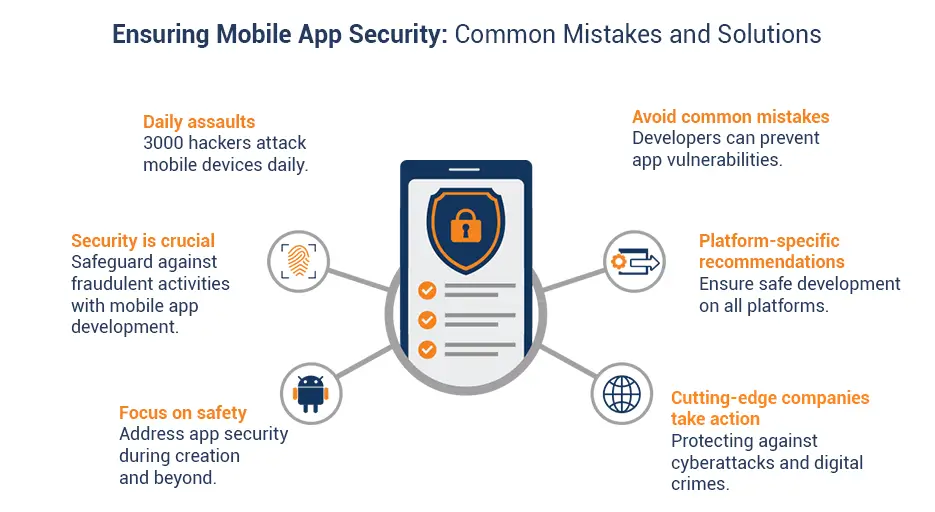Table of Contents
Today, we can have seamless access, thanks to every custom mobile app development company across the world available on Playstore, App Store as well as Windows Store. Mobile app development for online stores is constantly setting and breaking records every day. A mobile app usually asks for permission for several things including but not limited to contacts, cameras, galleries, personal information, and SMS to enhance the user experience in ways that have never been imagined before. But, all these aspects get into issues if mobile app security is not following proper protocols. If you are thinking why mobile app security is important, then below details can certainly help.

Need for Mobile App Security
International organisations and businesses are adopting the latest innovations with mobile app development to improve communication with customers and boost productivity among workers as the mobile app economy continues to grow quickly. Even companies that previously did not employ apps have begun to enter this sector of the market. Today, secure mobile apps are a requirement for any business. Moreover, smartphone applications are now fundamental to everyone’s lives and it conveys critical information.
According to a study, over 98% of mobile apps aren’t safe! The reason for this is an important flaw in their app design process, which puts mobile app maintenance and security testing until the end of the development process.
Whether or not each custom mobile app development company is using safe coding practices, represents a topic that many consumers and businesses need to pay more attention to.
As per custom app development services expert, the most common target for fraudulent activity seems to be mobile apps. Therefore, businesses should protect the apps they develop while utilising the enormous advantages that Mobile app development offers. In this article, we’re going to discuss the mobile app security best practices for ensuring the safety of mobile apps.
Top 10 Elements that Safeguard the Mobile Apps
We are witnessing times when technology has evolved so much that one can manage his professional as well as personal life using just one smart device. However, Mobile app development is accompanied by a few very dangerous curses that might include malware, security risks and a lot more. Given below are the best ways in which you can guarantee a cyber-attack-proof functioning of smart devices.
1) Construct a Protected Code
Most hackers utilise weaknesses and flaws in a program’s code as their means of getting into a smartphone app. All that’s required is a publicly accessible copy of your programme to try to do a reverse design and modify your code. According to research, approximately 12 million mobile devices can have malicious programmes at any hour. Be mindful of the level of safety of the code from the very first moment so you can make it difficult to crack. The source code should be compressed and concealed. It prevents hackers from decoding it. Consistently test, and as soon as flaws are found, fix them immediately. Make sure that the code is simple to fix and update. Keep the source code accommodating so that it can be secure. Make use of code signatures and code fortification.
2) Safeguard Every Piece of Information
Every element of information transferred through the custom mobile application development company needs to be secure. Encryption is the process of transforming plain text into a jumbled alphabetic maze that only those with an encryption key can decipher. This implies that even if information gets taken away, cybercriminals can’t access and exploit it for their objectives. When national government-run agencies request authorization to access smartphones and WhatsApp communications, you can see the significance of encryption. The attackers can’t get past if the agencies can’t do it on purpose.
3) Practice Solid Caution Around Libraries
Whenever utilising 3rd-party libraries, exercise extreme caution and thoroughly verify the code before including it in Mobile app development. Despite their usefulness, certain library components can be extremely hazardous when it comes to the app’s security. As an example, a security hole in a Library component may let hackers potentially run harmful code and bring down an operating system. Such kinds of weaknesses could go unnoticed for several years. To shield applications against flaws in libraries, programmers ought to make use of regulated in-house repositories and apply policy restrictions during the purchase.
4) Make use of Approved APIs Only
Poorly constructed, unauthorised APIs can unintentionally provide hackers access to systems that they could seriously abuse. When performing API requests, for instance, programmers can reuse permission information by caching it locally. Additionally, making it simpler to access APIs, makes life less stressful for even the best mobile app development company in USA. However, it also provides an opening for escalated privileges for cybercriminals. For best security, mobile app development experts advise central authorization of APIs.
5) Implement the Highest Level of Authorization
More robust authentication is becoming more crucial as a result of the observation that a number of the worst breaches of security result from inadequate authentication. Passwords and other forms of personal identification that serve as barriers to admission are often simply referred to as means of authentication. While the final users of the application do play a significant role in this, you might want them to be more cautious regarding authentication as a programmer. The applications you use can be programmed only to recognise strong alphanumeric credentials that must be changed approximately every 3 or 6 months. An increasingly popular authentication method uses both a permanent password and an unpredictable one-time password (OTP). Biometric identification methods like retinal imaging and fingerprints are also an alternative for particularly sensitive applications.
6) Use Technologies for Detecting Interference
When anybody tries to manipulate the code you wrote or insert detrimental code, there are methods to trigger alerts. To ensure that the code fails to execute in any way if manipulated, proactive tamper detection might be used.
7) Apply the Least Advantageous Approach
A software programme should only have access to features that it requires to function, according to the principle of the least amount of privilege. A custom mobile app development agency shouldn’t ask for any more rights than are necessary for it to operate. Don’t ask for permission to the user’s connections if you do not need it. Avoid making pointless connections to the network. Progressive modelling of threats should be done as the source code is updated because numerous more instances heavily depend on the particulars of the application.
8) Implement Suitable Session Management
On mobile devices, ‘sessions’ are substantially longer than they are on desktops. The server now has greater difficulty in managing sessions. Tokens should be used for recognising sessions as opposed to device identification. Tokens are more secure in the event of theft or destruction of devices because they can be terminated at any point in time. Activate remote sign-off as well as distant information erasing from a device that has been stolen or lost.
9) Utilize the Most Effective Cryptography Methods and Tools
As per enterprise mobile app development company, key governance is essential if you want encryption initiatives to be successful. Always avoid hard-coding the keys since doing so makes them simple targets for criminal activity. Always refrain from storing keys publicly on the machine; always keep them in safe receptacles. By today’s security standards, some frequently used cryptographic systems, such as SHA1 and MD5, are inadequate. Use only the most recent, trustworthy APIs, such as AES encryption with 256 bits and SHA-256 authentication.
10) Constant Testing
The process of protected Mobile app development never comes to an end. Fresh hazards are developing, necessitating inventive solutions. Spend money on threat modelling, penetration testing, as well as emulators to regularly check the applications for weaknesses. These issues ought to be resolved with each upgrade, and solutions have to be made accessible as necessary. Many well-known data breaches have undoubtedly awakened everyone to the significance of information security, and in the years to come, everyone from businesses to consumers are going to treat cybersecurity with greater importance than before.
The effectiveness of mobile apps will increasingly depend more on security than on functionality or attractiveness. The aforementioned recommendations will assist you in keeping the application secure as oysters and achieving client and consumer satisfaction.

Top 8 Mobile Application Safety Development Problems and How to Prevent Them
With the increase in the number of smartphones, smartphone applications, and solutions that use the cloud, security for applications is becoming increasingly challenging. However, for an assortment of reasons, some developers of mobile apps frequently fail to comprehend the value of protection in mobile applications and make mistakes such as those listed below:
1) Inadequate Server-Side Management
Any connection that exists between the custom mobile app development company and its users always goes through a server. Servers are consistently the major objective of cybercriminals.
You can take proactive precautions to ensure server-side privacy in a variety of ways, including hiring an experienced security professional internally to just use a testing tool and keep it protected. When programmers disregard the server-level security guidelines, an extremely serious issue emerges. Following are a few fundamental explanations explaining the same:
- A limited security expenditure
- Disproportionate dependence on the mobile operating system for improvements in safety and accountability
- Developer experimenting with a new language with little security knowledge
- Risks associated with development for multiple platforms
To avoid inadequate server-side control systems, programmers may implement a few measures while developing mobile applications. Given below are a few of such practices:
Screening the Application
Screening the applications for mobile devices is the most effective approach to protect them from server-level weaknesses. Use a built-in detector for examining the applications you are using. An autonomous scanner finds fundamental problems that can be fixed by programmers with minimal investment.
Obtain an exhaustive assessment via mobile app development experts
Numerous digital scanners for security identify a lot of shortcomings, sometimes with erroneous positives as well as incorrect negatives. Therefore, it is essential to examine each one carefully before employing a tool for testing. Understanding which risks are significant and close to zero importance is dependent on the aforementioned assessment.
Use reliable programming conducts
If the source code doesn’t seem to be secure, no amount of security measures you take will be able to prevent your app from being vulnerable. Putting into effect safe programming behaviours may need some time and work, but it will undoubtedly prove advantageous in the years to come.
Although the above represents all you must do to put together a secure app, if you require more sophisticated protection, you might consider hiring mobile app development experts in cybersecurity to help you throughout the entire creation journey.
2) Insufficient Safe Storage for Information
Another security gap occurs when there is no safe place to store information throughout the development of an app. Relying on client storage space to store the information is an established practice among app designers. Client storage facilities, on the other hand, are not an environment where safety violations are unthinkable. In other words, there is a possibility of a loss of information if the equipment gets lost or manipulated.
The best way to safeguard your place of data storage across different operating systems is to add additional encryption on top of the respective OS’s standard base layer. This substantially enhances the overall safety of the mobile application and minimises the programmer’s reliance on conventional encryption.
3) The Transport Layer Security is Unsustainable
The layer of transport refers to the path the data takes as it travels from the client to the server’s network and the other way around. Anyone can access and manipulate the data wherever they please since there is a lacklustre transport layer. Identity fraud and intimidation get triggered by the above.
Engineers frequently employ SSL and TLS protocols to secure communication as a way to avoid problems. The issue comes about because not all SSLs are created equal. Many of these are either self-marked or distributed by unaffiliated organisations. To protect mobile apps, the layer that transports data can be strengthened in the manners that follow:
- Make SSL chain authentication mandatory.
- To prevent mismatched SSL sessions, avoid disclosing an individual’s session ID.
- If the smartphone application notices a fraudulent declaration, it will notify the person using it.
- Use reasonable lengths for keys and business-standard coding packages given that they are comparatively more reliable.
- Employ the SSL of external businesses, social media platforms, and more when the application executes a function using a browser.
- Never communicate passwords or other confidential information over other means of communication (which might include SMS, MMS, or alerts).
4) Sluggish Encryption
The majority of the time, app builders refrain from employing the correct encryption controls to safeguard data as it traverses from the app to the server and back again. Due to the aforementioned mistake, the information provided by the user could be intercepted through a particular kind of breach referred to as ‘man-in-the-middle’. The worst-case scenario is that when you hire mobile app development firm and they fail to incorporate an additional alert that will inform an individual that their communications are in imminent danger of being compromised.
If you want to safeguard data between the application’s server and the mobile device, guarantee that your application uses SSL (Secure Sockets Layer) authentication. Make certain that the programmer checks the application to determine if it is going to cease functioning if an unauthorized 3rd-party is collecting the personally identifiable information.
5) Lack of Binary Protections
Someone with malicious intent can simply disassemble the source code of an application and put it in malicious software if binary safeguards aren’t there. This can be an extremely serious problem given that it may lead to fraudulent activity, loss of revenue, and theft of personal information.
It is of the utmost importance to use binary strengthening measures to avoid this. It is used to analyse and modify documents to protect them from prevalent vulnerabilities. As a result, weaknesses in outdated programmes can be identified and addressed without a requirement for the program’s source code. Checksum control systems, bootloader recognition oversight, as well as certificate anchoring measures ought to all be embedded in the application using safe programming techniques.
6) Unintentional Leakage of Data
Unintentional data leakage refers to storing app information within unreliable and unsafe areas on a smartphone or tablet. The information is kept in a place where other individuals and activities can access it.
As a result, user privacy is violated, which leads to data usage that is not authorised. People frequently mix up unintentional data spilling and unguarded storage of data. These two are distinctive, though. Data Leakage is brought on by problems like OS imperfections and inadequate security of the system, and these are outside of the grasp of developers of mobile apps.
Although causes for unsecured storage of data are entirely under the control of an application designer. Scanning for generic leakage indicators, such as caching, logging, programme backgrounding, as well as HTML storage of info, is going to assist you to prevent Data Leakage.
7) Ineffective Session Management
Inadequate session management references the persistence of the session even after the user exits the programme for a long time. Numerous e-Commerce applications favour offering sessions that are longer to hasten the purchasing process, and other businesses follow suit to improve customer experience. On the other hand, if the mobile device goes missing, this practice could be problematic. Anyone who has access to such a device can hijack the programme and extract important information.
Re-authentication is the best way to strike a balance between rapidity and safety mitigation while carrying out crucial tasks such as making purchases or obtaining ownership of information. When you do this, you may provide users with the necessary access without sacrificing the security of mobile applications.
8) Ineffective Authentication
A malicious individual can gain anonymous access to the smartphone application or underlying server by exploiting weak or absent authentication.
Mobile app security standards may need an offline authentication process to ensure availability because internet connections on mobile devices are not as trustworthy as internet connections through web pages.
Creators of mobile apps need to be aware that such requirements can lead to weaknesses in security. Applications are typically prone to attack in their offline configuration. They may provide low-authorization individuals with the ability to perform tasks that are only available to administrators. Therefore, it makes sense to limit logins while in the connected state.
Book 30 Minutes Free Consultations with A3Logics Experts to Start Your App Journey Today!
How Can You Secure an Android App?
As per the Android app development agency, you can rapidly expand the user base and grow the organisation simply by keeping the application protected. The best practices listed below will help enhance the security associated with your Android application:
1) Store information about users appropriately
Storing your customer’s data effectively is the most significant component of technological assurance. The device you’re using has both internal and external memory as an option for storing information. The distinguishing factor between these two approaches is as outlined below:
To improve security, you should not save user information on Android’s external memory because it can be accessed by other applications and used or altered. However, if the customer’s data has been stored internally, it can be encrypted through the use of a password. But the username and password aren’t maintained in the device’s database. The essential OS elements are safeguarded whenever a user initiates this type of encryption.
2) Android OS authorization
Any communication among mobile apps in a sandbox environment is subject to approval from the user. Therefore, programmers should build this function using a sandbox infrastructure that is trustworthy and secure if you intend for the Android application to be welcoming. Additionally, it makes sure that services don’t gather information about you or use a disproportionate amount of bandwidth.
3) Deploy HTTPS
An HTTPS conjunction is what should be used throughout every aspect of the application’s communication with the web server. Using HTTP as opposed to HTTPS may render the device defenceless against multiple fraudulent activity areas that are capable of altering the information contained in traffic sent via HTTP and may trigger the smartphone app to function in an unforeseen manner. Many people who use Android frequently interact with several open unsecured wireless networks in public locations.
4) Implementing GCM as opposed to SMS
In the past, SMS was a means for transferring information between servers and programmes; although nowadays, we make use of GCM (Google Cloud Messaging). However, you ought to prefer GCM over SMS if you haven’t done so already. The reason for this is having discovered that SMS communication doesn’t seem to be secure or protected.
That’s all there is to be done when it boils down to safeguarding your Android app. Although there are additional precautions you can take, including user input authentication and employing ProGuard prior to uploading the application. The methods above are an absolute prerequisite for protection.
How Can You Secure Your iOS Mobile App?
iOS has been one of the world’s most trustworthy mobile operating systems owing to its safety functions and Apple-boundaries. Developers disregard security when developing an application for the iOS platform.
Breaches of information, as well as Man in the Middle attacks, are two examples of significant hazards with the iOS operating system. These techniques are intended to assist you to develop safe applications for iOS that safeguard your users:
1) The importance of KeyChain API
You need to employ the security features by Apple to save personally identifiable information in applications running on iOS. By presenting the application you’re developing with an approach for saving a quantity of user information in a database. It is securely known as the keychain and APIs aid you in handling privacy and security issues.
You are given permission to safeguard passwords along with additional sensitive information within the keychain. It includes card numbers and even a couple of lines of text.
2) Cybersecurity in networks
As per top company providing mobile app development services in USA, Apple has earned a reputation for having rigorous privacy procedures. The company put forward App Transport Security just a few years ago, a feature that allows 3rd-party smartphone apps to send out requests to the network over an interface that is progressively becoming stronger, including HTTPS.
3) SSL Certificate Pinning
We may defend against the Man in the Middle assault by employing a process termed SSL Certificate Pinning. The ‘chain of trust’ of the certificate must be present for SSL. When communication first starts, it is determined whether or not an SSL Certificate Command recognises the server’s encrypted certificate.
To ensure that the programme only communicates with the designated server, we may apply SSL Certificate Pinning. The above may be accomplished by storing the destination server’s certificate for SSL inside the application’s package.
Even if you use the aforementioned techniques, the application you’re developing might continue to be susceptible. Cybercriminals and app developers are continuously at war. However, you ought to implement all the necessary precautions imaginable as an app developer to guarantee the safe keeping of the apps for both iOS and Android.
Summary
According to studies, there are approximately 3000 daily assaults by hackers or one every forty seconds. For reasons such as these, security for mobile devices is an essential consideration for all organisations. If your objective is to safeguard against fraudulent activities in the years to come and are hoping to develop an application of your own in 2025, you need to devote particular attention to safe enterprise mobile application development.

As per the top mobile app development companies in USA, the responsibility of keeping an app safe should be in check during the creation of the application. One must not over check it even following the time the custom mobile app development company releases the app and becomes prosperous. Through this blog, we’ve spoken about the most common mistakes that developers commit when building apps and how they can avoid them. Furthermore, we looked at several platform-specific recommendations for developing safe apps.
Several cutting-edge companies routinely take measures like these to guard against cyberattacks and digital crimes to safeguard the information encompassed within their apps. According to expectations, from 2023 to 2025, worldwide expenditures on mobile app security and monitoring can reach more than two trillion dollars.
Bottom Line
Unquestionably, as the possibility of malicious behaviour gets higher, programmers’ primary concerns have concentrated on secured Mobile app development. Users become uninterested in installing insufficiently trustworthy applications as a consequence. The aforementioned recommendations will minimize all of your concerns about creating a safe smartphone application for the people who use it.
FAQs
How to Construct a Protected Code?
The source code should be compressed and concealed to prevent hackers from decoding it. Consistently test, and as soon as flaws are found, fix them immediately
When to stop testing?
The process of protected Mobile app development never comes to an end. Fresh hazards are developing, necessitating inventive solutions. Spend money on threat modelling, penetration testing, as well as emulators to regularly check the applications for weaknesses.
What are the best practices for security in mobile apps?
Best methods include encryption in order to secure sensitive data, employing security-based authentication techniques, frequently making updates and patches to apps, and conducting rigorous security tests.
What are the most effective methods to ensure the security of mobile apps?
The best methods to master security for mobile apps include conducting regular security audits and implementing secure programming practices, using high-quality encryption techniques and adhering to mobile app security guidelines.
What are the most important security standards for mobile apps?
Mobile application security standards include those of the OWASP Mobile Application Security Verification Standard (MASVS) and the Payment Card Industry Data Security Standard (PCI DSS) and the National Institute of Standards and Technology (NIST) Mobile Application Security guidelines.
How can encryption enhance the security of mobile apps?
As per the top iOS app development companies, the use of encryption can enhance security of mobile apps by securing information so that it’s not accessible to users who are not authorized.
Why is a regular security test vital for the security of mobile apps?
Regular testing of security is essential to ensure the security of mobile apps as it helps to identify vulnerabilities and flaws in the app’s code or the infrastructure. By identifying and repairing the weaknesses, companies will be able to greatly reduce the chance of data breaches, hacking and other security-related incidents. To know more you can always connect with top mobile app development agencies like A3Logics.






